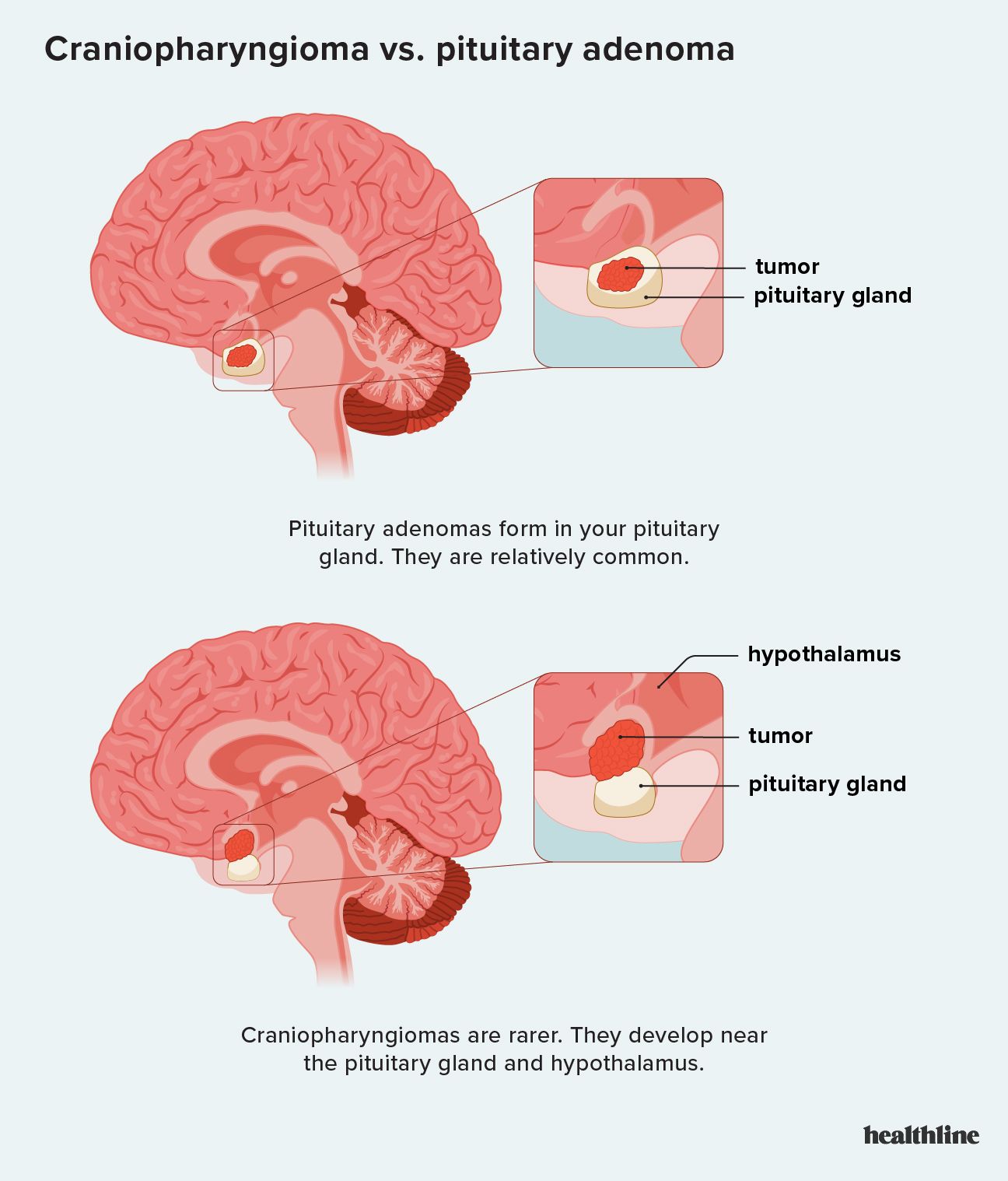Benign pituitary tumors are not cancerous but can still cause problems if they compress your brain tissue or optic nerves. Some can lead to the under- or overproduction of certain hormones.
Your pituitary gland is a pea-size gland at the base of your brain that produces many hormones. Tumors that develop in your pituitary gland can be cancerous or noncancerous, also called benign.
Let’s examine some of the most common types of benign pituitary tumors.
Here’s a look at the types of benign tumors that can develop in or near your pituitary gland.
Pituitary neuroendocrine tumors (pituitary adenoma)
Pituitary adenomas, or pituitary neuroendocrine tumors, are the
Most pituitary neuroendocrine tumors are benign and
They’re subclassified as microadenoma if they’re smaller than
They can also be subdivided into functional and nonfunctional tumors.
Nonfunctional tumors
Nonfunctional tumors don’t interfere with the production of hormones. But they can cause problems if they grow large enough to compress brain tissue.
Functional tumors
Functional tumors cause hormonal problems. They’re named for the hormone they disrupt. Here’s a general breakdown from the
- Prolactinomas: Prolactinomas make up about 40% of pituitary tumors. They produce excess prolactin.
- Somatotroph adenomas: These make up about 20% of adenomas and produce excess growth hormone.
- Corticotroph adenomas: These make up 10% of pituitary tumors and produce excess adrenocorticotropic hormone (ACTH).
- Gonadotroph adenomas: These produce excess luteinizing hormone and follicle-stimulating hormone.
- Thyrotroph adenomas: These are very rare. They produce excess thyroid-stimulating hormone.
- Plurihomronal adenomas: These produce more than one type of hormone. The most common combination is prolactin and growth hormone.
Craniopharyngiomas
Craniopharyngiomas are estimated to occur in
They arise near the pituitary gland and can cause pituitary compression. This compression can lead to the underproduction of pituitary hormones.
About

Rathke cleft cysts
Rathke cleft cysts are common fluid-filled tumors that develop near or on the pituitary gland. Most are small and don’t cause symptoms.
Most Rathke cleft cysts are diagnosed between the ages of
Gangliocytomas
Pituitary gangliocytomas are rare tumors that develop in
Pituicytomas
Pituicytomas develop in the posterior pituitary gland and may cause hormonal problems. Only
Potential symptoms
- headaches
- visual changes, like blurry vision or blindness
- facial numbness or pain
- loss of consciousness
- dizziness
Somatotroph adenoma symptoms
In children, high growth hormone can cause:
- very tall height
- rapid growth
- increased sweating
- joint pain
Adults may have symptoms like:
- hand and foot growth
- facial bone changes
- widening of teeth
- protruding of jaw
- deepening voice
- thickening of tongue
- snoring
- sleep apnea
- thickened skin
- increased body hair
- numbness and tingling in hands
- carpal tunnel syndrome
- high blood pressure
- diabetes
- heart disease
Corticotroph adenoma symptoms
Corticotrophin-secreting adenomas can cause:
- purple stretch marks on your chest and abdomen
- unexplained weight gain, especially in:
- face
- chest
- abdomen
- facial swelling and redness
- acne
- extra fat on the back of your neck
- mood changes or depression
- easy bruising
- diabetes
- high blood pressure
- loss of sex drive
- loss of menstruation
- weakened bones
Prolactinoma symptoms
Prolactin-secreting adenomas can cause:
- loss of menstruation
- atypical breast milk production
- breast growth and milk production in males
- erectile dysfunction
- bone weakness
- infertility
- loss of sex drive
TSH-secreting adenoma symptoms
These can cause:
- rapid heart rate
- tremors
- increased appetite
- weight loss
- feeling overly hot or cold
- sweating
- trouble sleeping
- anxiety
- lump on your neck over the thyroid gland
- frequent bowel movements
Gonadotroph adenoma symptoms
Gonadotropin-secreting adenomas rarely cause symptoms. They might cause higher levels of sex hormones that can cause irregular menstruation or early signs of puberty.
There are
Many different
- AIP
- GNAS
- USP8
- USP48
- BRAF
Pituitary tumors
Syndromes that increase your risk
- multiple endocrine neoplasia type I or IV
- McCune-Albright syndrome
- Carney complex
- familial isolated pituitary adenoma
Many pituitary tumors are discovered during brain imaging for unrelated reasons. Blood tests can reveal hormone changes that suggest a functional pituitary tumor.
Surgery is the primary treatment for most pituitary tumors. Surgical techniques include:
- Transsphenoidal surgery: An incision is made through your nose to access your pituitary gland through the sphenoid bone.
- Craniotomy: Part of the front or side of the skull is removed to access your pituitary gland and remove the tumor.
Medications can help treat high or low hormone levels.
You might receive radiation therapy if:
- surgery isn’t an option
- the tumor comes back after surgery
- the tumor causes symptoms that medication cannot control
Attend all your follow-up appointments after your diagnosis to determine whether your tumor is getting bigger. Also let your doctor know if you notice a change in your symptoms, like worsening vision loss.
Here are some frequently asked questions people have about benign pituitary tumors.
How serious is a tumor on the pituitary gland?
Some pituitary tumors cause no or minimal symptoms. Functioning tumors can cause hormonal problems, which can have a
Do benign pituitary tumors need to be removed?
A benign pituitary tumor may not need to be removed if it’s not causing problems and your doctor thinks it’s going to progress slowly.
What is the survival rate for benign pituitary tumors?
Many benign pituitary tumors do not affect life span. Tumors that produce excess hormones may lead to premature death if medications are not effective.
Benign pituitary tumors are not cancerous. However, they can still cause problems if they compress brain tissue.
Your doctor may recommend removing a benign pituitary tumor if they expect it to get bigger and cause problems. Small and slow-growing tumors often don’t require treatment.
